Ahmad Abdellatif
An Approach for Auto Generation of Labeling Functions for Software Engineering Chatbots
Oct 09, 2024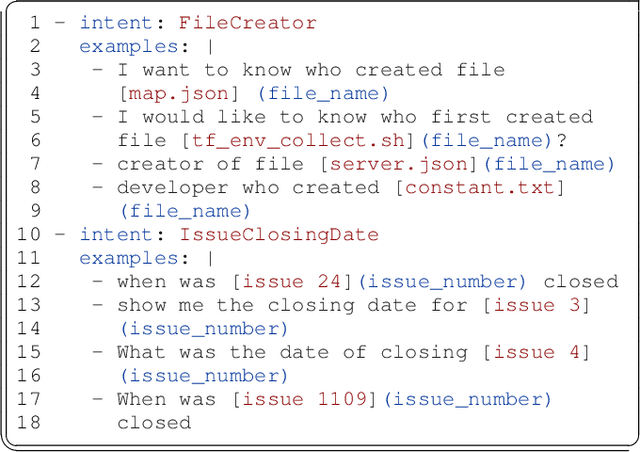

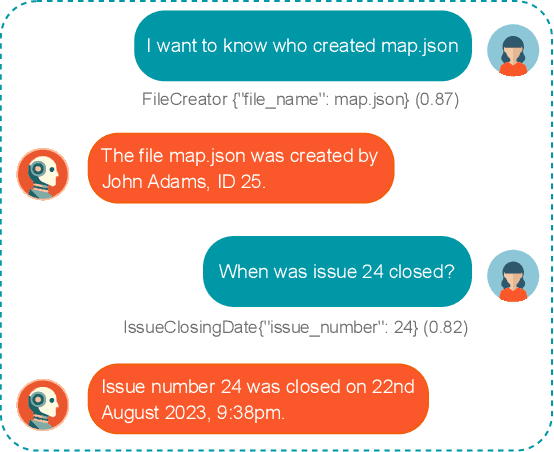

Abstract:Software engineering (SE) chatbots are increasingly gaining attention for their role in enhancing development processes. At the core of chatbots are the Natural Language Understanding platforms (NLUs), which enable them to comprehend and respond to user queries. Before deploying NLUs, there is a need to train them with labeled data. However, acquiring such labeled data for SE chatbots is challenging due to the scarcity of high-quality datasets. This challenge arises because training SE chatbots requires specialized vocabulary and phrases not found in typical language datasets. Consequently, chatbot developers often resort to manually annotating user queries to gather the data necessary for training effective chatbots, a process that is both time-consuming and resource-intensive. Previous studies propose approaches to support chatbot practitioners in annotating users' posed queries. However, these approaches require human intervention to generate rules, called labeling functions (LFs), that identify and categorize user queries based on specific patterns in the data. To address this issue, we propose an approach to automatically generate LFs by extracting patterns from labeled user queries. We evaluate the effectiveness of our approach by applying it to the queries of four diverse SE datasets (namely AskGit, MSA, Ask Ubuntu, and Stack Overflow) and measure the performance improvement gained from training the NLU on the queries labeled by the generated LFs. We find that the generated LFs effectively label data with AUC scores of up to 85.3%, and NLU's performance improvement of up to 27.2% across the studied datasets. Furthermore, our results show that the number of LFs used to generate LFs affects the labeling performance. We believe that our approach can save time and resources in labeling users' queries, allowing practitioners to focus on core chatbot functionalities.
Automatic Detection of LLM-generated Code: A Case Study of Claude 3 Haiku
Sep 02, 2024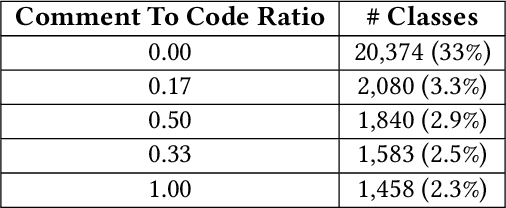
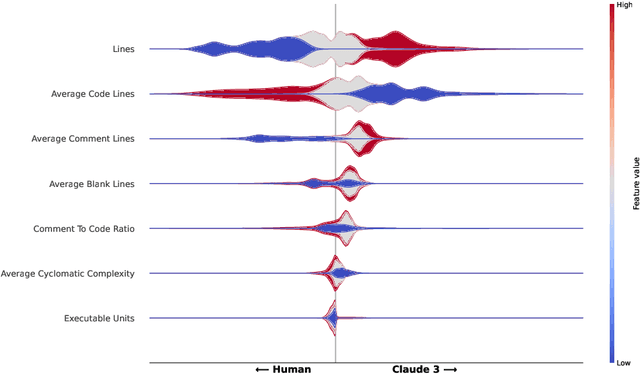
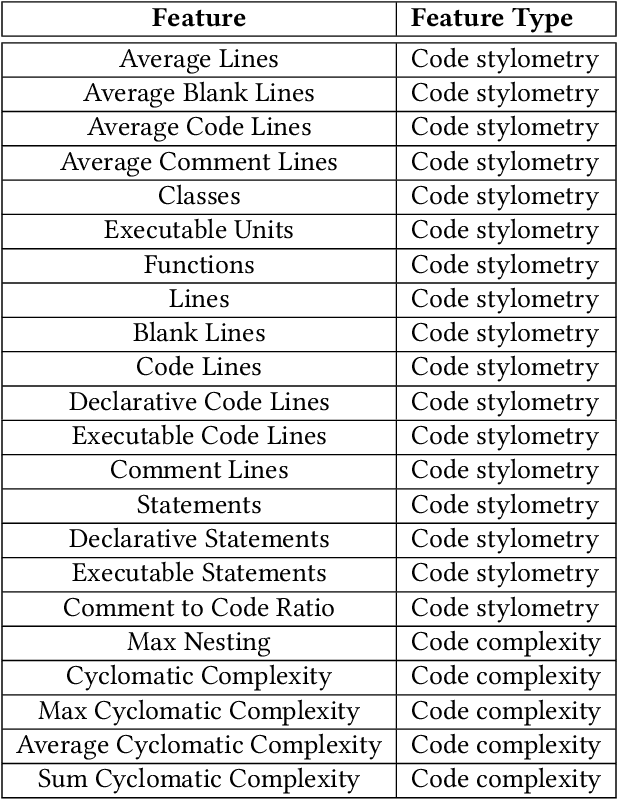
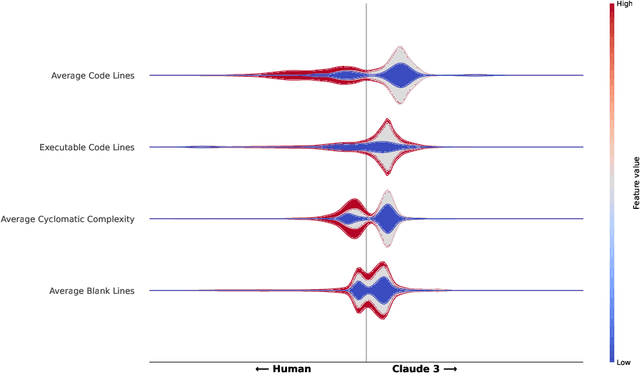
Abstract:Using Large Language Models (LLMs) has gained popularity among software developers for generating source code. However, the use of LLM-generated code can introduce risks of adding suboptimal, defective, and vulnerable code. This makes it necessary to devise methods for the accurate detection of LLM-generated code. Toward this goal, we perform a case study of Claude 3 Haiku (or Claude 3 for brevity) on CodeSearchNet dataset. We divide our analyses into two parts: function-level and class-level. We extract 22 software metric features, such as Code Lines and Cyclomatic Complexity, for each level of granularity. We then analyze code snippets generated by Claude 3 and their human-authored counterparts using the extracted features to understand how unique the code generated by Claude 3 is. In the following step, we use the unique characteristics of Claude 3-generated code to build Machine Learning (ML) models and identify which features of the code snippets make them more detectable by ML models. Our results indicate that Claude 3 tends to generate longer functions, but shorter classes than humans, and this characteristic can be used to detect Claude 3-generated code with ML models with 82% and 66% accuracies for function-level and class-level snippets, respectively.
Is ChatGPT a Good Software Librarian? An Exploratory Study on the Use of ChatGPT for Software Library Recommendations
Aug 09, 2024Abstract:Software libraries play a critical role in the functionality, efficiency, and maintainability of software systems. As developers increasingly rely on Large Language Models (LLMs) to streamline their coding processes, the effectiveness of these models in recommending appropriate libraries becomes crucial yet remains largely unexplored. In this paper, we assess the effectiveness of ChatGPT as a software librarian and identify areas for improvement. We conducted an empirical study using GPT-3.5 Turbo to generate Python code for 10,000 Stack Overflow questions. Our findings show that ChatGPT uses third-party libraries nearly 10% more often than human developers, favoring widely adopted and well-established options. However, 14.2% of the recommended libraries had restrictive copyleft licenses, which were not explicitly communicated by ChatGPT. Additionally, 6.5% of the libraries did not work out of the box, leading to potential developer confusion and wasted time. While ChatGPT can be an effective software librarian, it should be improved by providing more explicit information on maintainability metrics and licensing. We recommend that developers implement rigorous dependency management practices and double-check library licenses before integrating LLM-generated code into their projects.
On the Variability of AI-based Software Systems Due to Environment Configurations
Aug 05, 2024



Abstract:[Context] Nowadays, many software systems include Artificial Intelligence (AI) components and changes in the development environment have been known to induce variability in an AI-based system. [Objective] However, how an environment configuration impacts the variability of these systems is yet to be explored. Understanding and quantifying the degree of variability due to such configurations can help practitioners decide the best environment configuration for the most stable AI products. [Method] To achieve this goal, we performed experiments with eight different combinations of three key environment variables (operating system, Python version, and CPU architecture) on 30 open-source AI-based systems using the Travis CI platform. We evaluate variability using three metrics: the output of an AI component like an ML model (performance), the time required to build and run a system (processing time), and the cost associated with building and running a system (expense). [Results] Our results indicate that variability exists in all three metrics; however, it is observed more frequently with respect to processing time and expense than performance. For example, between Linux and MacOS, variabilities are observed in 23%, 96.67%, and 100% of the studied projects in performance, processing time, and expense, respectively. [Conclusion] Our findings underscore the importance of identifying the optimal combination of configuration settings to mitigate performance drops and reduce retraining time and cost before deploying an AI-based system.
Predicting the First Response Latency of Maintainers and Contributors in Pull Requests
Nov 13, 2023Abstract:The success of a Pull Request (PR) depends on the responsiveness of the maintainers and the contributor during the review process. Being aware of the expected waiting times can lead to better interactions and managed expectations for both the maintainers and the contributor. In this paper, we propose a machine-learning approach to predict the first response latency of the maintainers following the submission of a PR, and the first response latency of the contributor after receiving the first response from the maintainers. We curate a dataset of 20 large and popular open-source projects on GitHub and extract 21 features to characterize projects, contributors, PRs, and review processes. Using these features, we then evaluate seven types of classifiers to identify the best-performing models. We also perform permutation feature importance and SHAP analyses to understand the importance and impact of different features on the predicted response latencies. Our best-performing models achieve an average improvement of 33% in AUC-ROC and 58% in AUC-PR for maintainers, as well as 42% in AUC-ROC and 95% in AUC-PR for contributors compared to a no-skilled classifier across the projects. Our findings indicate that PRs submitted earlier in the week, containing an average or slightly above-average number of commits, and with concise descriptions are more likely to receive faster first responses from the maintainers. Similarly, PRs with a lower first response latency from maintainers, that received the first response of maintainers earlier in the week, and containing an average or slightly above-average number of commits tend to receive faster first responses from the contributors. Additionally, contributors with a higher acceptance rate and a history of timely responses in the project are likely to both obtain and provide faster first responses.
A Comparison of Natural Language Understanding Platforms for Chatbots in Software Engineering
Dec 04, 2020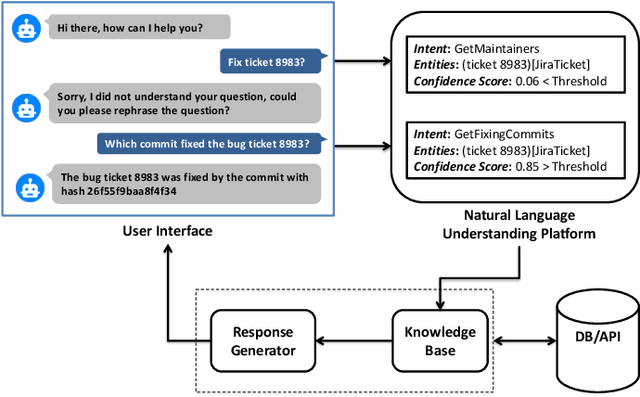


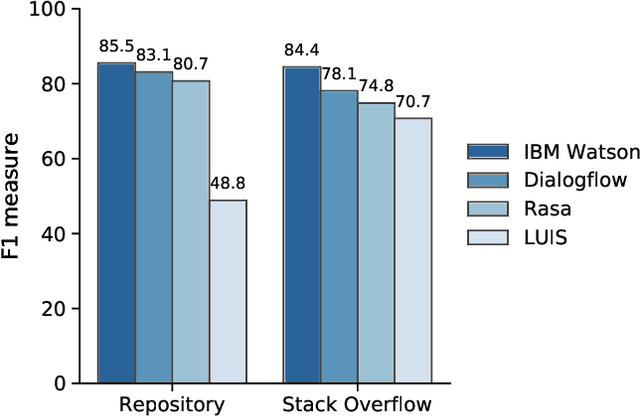
Abstract:Chatbots are envisioned to dramatically change the future of Software Engineering, allowing practitioners to chat and inquire about their software projects and interact with different services using natural language. At the heart of every chatbot is a Natural Language Understanding (NLU) component that enables the chatbot to understand natural language input. Recently, many NLU platforms were provided to serve as an off-the-shelf NLU component for chatbots, however, selecting the best NLU for Software Engineering chatbots remains an open challenge. Therefore, in this paper, we evaluate four of the most commonly used NLUs, namely IBM Watson, Google Dialogflow, Rasa, and Microsoft LUIS to shed light on which NLU should be used in Software Engineering based chatbots. Specifically, we examine the NLUs' performance in classifying intents, confidence scores stability, and extracting entities. To evaluate the NLUs, we use two datasets that reflect two common tasks performed by Software Engineering practitioners, 1) the task of chatting with the chatbot to ask questions about software repositories 2) the task of asking development questions on Q&A forums (e.g., Stack Overflow). According to our findings, IBM Watson is the best performing NLU when considering the three aspects (intents classification, confidence scores, and entity extraction). However, the results from each individual aspect show that, in intents classification, IBM Watson performs the best with an F1-measure > 84%, but in confidence scores, Rasa comes on top with a median confidence score higher than 0.91. Our results also show that all NLUs, except for Dialogflow, generally provide trustable confidence scores. For entity extraction, Microsoft LUIS and IBM Watson outperform other NLUs in the two SE tasks. Our results provide guidance to software engineering practitioners when deciding which NLU to use in their chatbots.
 Add to Chrome
Add to Chrome Add to Firefox
Add to Firefox Add to Edge
Add to Edge